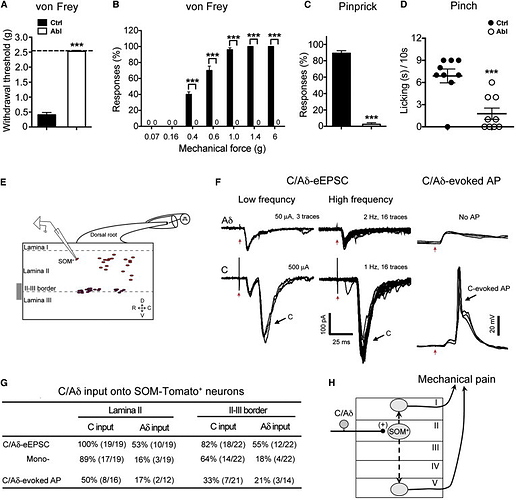Looking across the literature, one sees widely divergent values for baseline mechanical, thermal and chemical pain behaviors. This prompts the question, is there an ‘average’ expected value? In some ways, I don’t want to know what is expected, since this influences how I perform my behavioral assays (even if subconsciously). If you have a control group, and you perform your assays in a consistent manner, the results are what they are. Nevertheless, having some working range to peg your own results to can help one to assess whether the assay is being performed correctly or if the test subjects truly are quite different than the average mouse.
@jmogil and others have shown that different strains have different basal pain sensitivities, but let’s take the most commonly used mouse, C57BL6/J, and share the typical expected values for various assays.
Von Frey Assay
Up-Down
Baseline anywhere from 0.4g to 1.0g
Xu, Z.-Z., Kim, Y.H., Bang, S., Zhang, Y., Berta, T., Wang, F., Oh, S.B., and Ji, R.-R. (2015). Inhibition of mechanical allodynia in neuropathic pain by TLR5-mediated A-fiber blockade. Nat Med 21, 1326–1331.
PWT = ~ 1.0g
Hargreaves Assay
… Will add more later.
1 Like
This was exactly what I was trying to get at with my paper last year.
These values are most often only specific to one lab and it is hard to compare these (even the Hargreaves assay, the light could be used at different power settings, or the glass surface the animals are placed on can be vastly different between labs) between different labs. 1) animals housed differently will have different thresholds 2) the experimenter affects the thresholds (whether male or female or alone the experimenters smell can affect the animals) 3) when experiments are performed affects the thresholds 4) what different labs call a response (whether a flare of the toes is called an actual response or just the withdrawal of the paw is considered a response). 5) noise in the facility can also affect your experimental outcome
I think this is a very hard comparison to make between labs and I would caution you to do so.
If you want to see a reference for von Frey, needle, light touch, hargreaves or cold you can look at my paper I only used male C57 mice throughout the study.
http://www.sciencedirect.com/science/article/pii/S1526590015008871
Thanks for the response @fmoehring. I agree that looking for ‘normal’ is tricky and maybe misguided. However, it is the case the pain researchers (who review our papers) do have a sense of what ‘normal’ is. In a recent submission, a reviewer said that my baseline of 0.6 g was “too low”. that’s nonsense and this person is wrong, since as you and others have shown, the baseline thresholds are highly dependent on a number of environmental variables. Still, this presumption exists and so it’s good to know what people in the field take as the average, if for no other reason than to pre-empt criticisms when your behavioral data are outside the range.
There are a ton of factors that would affect your baseline. I support the notion that it is hard to compare between labs. At the same time, in my lab and with our technique I seldom observe baselines below 0.5g. Now, your definition plays an important role because you are either making an average of your observations, using a 50% withdrawal threshold as in example 2, or any other variation that is specific to the lab. There is more of an issue of what researchers see as “normal” in their lab and not what really is “normal”.


